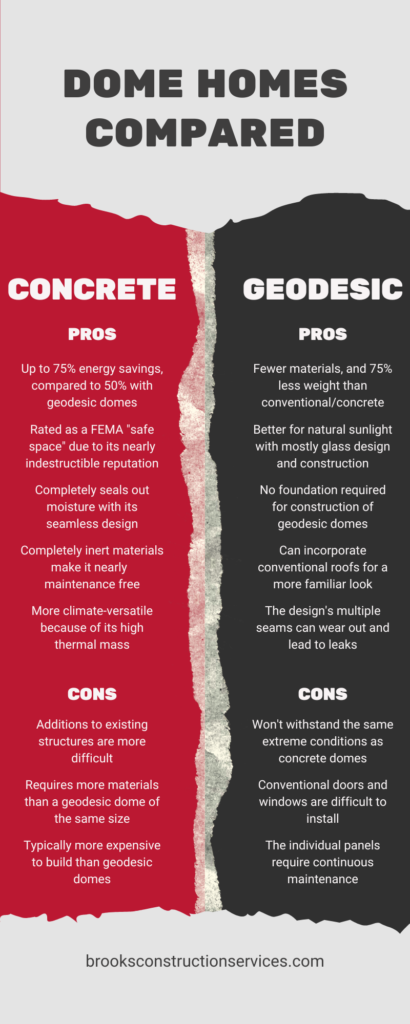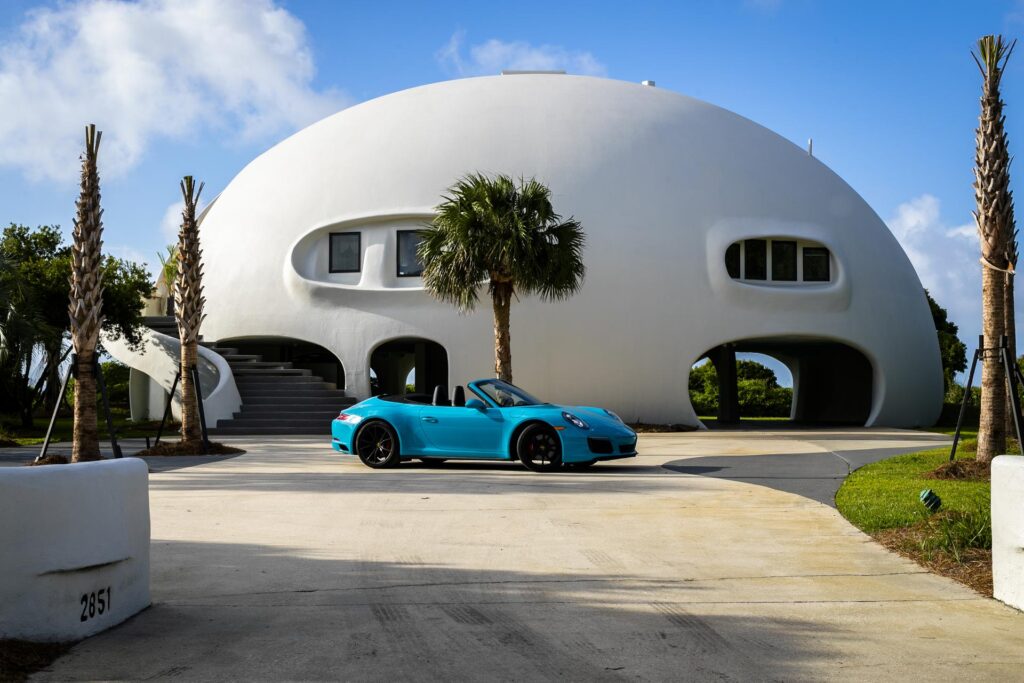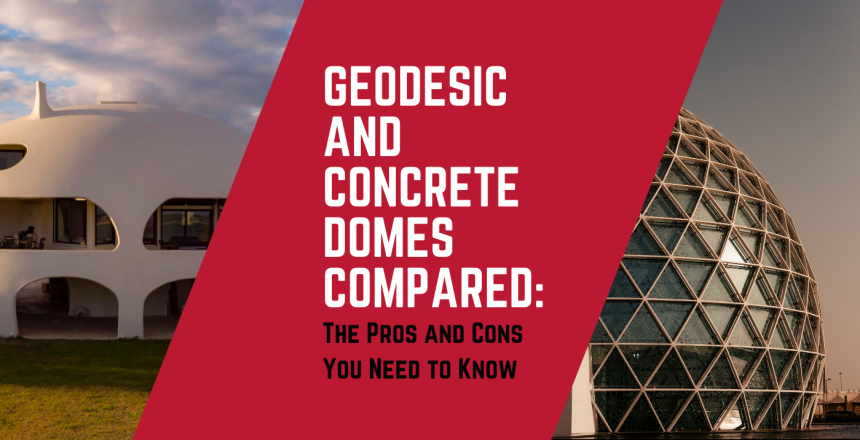Boxy homes are a safe and familiar default design for homebuyers. But they’re wasteful: more materials, more heating and cooling, and less durability.
In the second half of the 20th century, designers started looking beyond the cube. This search for a better solution brought about two eye-catching new building designs: geodesic and concrete domes.
Today, you can build beautiful and unique residences with either method. The two dome designs each offer unique benefits and challenges. So how do you know what’s right for your next home?
Comparing Geodesic and Concrete Domes
At first glance, the two domes are clearly very different on the outside: one has flowing curves and contours, while the other sports a unique quiltwork of geometric facets. But the two spherical designs both provide incredible benefits for homeowners looking to reduce energy costs and invest in eco-friendly alternatives to conventional construction.
On the inside, geodesic and concrete domes are anything but identical. And those differences are important when you look at building your own dream home.
What Is A Geodesic Dome?
Geodesic domes use panels, most often triangles, that are interconnected to form a sphere. The inherent rigidity of the triangles make these domes incredibly strong while also minimizing material use.
Originally designed and evangelized by R. Buckminster Fuller starting in the 1940s, geodesic domes were created for the sake of efficiency, fast assembly, and strength. Today, these dome structures are used for homes, hotels, greenhouses, and public gathering areas.

Architects and engineers have used many different materials for geodesic domes. Originally, wood frames and panels comprised the majority of the structures. But with technological advancements, including computer-aided design, modern geodesic domes can be built with steel frames, glass, and even bioceramic materials to reduce waste, increase energy efficiency, and make the structures even lighter.
What’s the Difference Between Geodesic and Concrete Domes?

Both types of domes share many similarities, but a couple key differences set them apart.
The construction methods differ greatly, with concrete domes utilizing a single-piece design. This contrasts with the geodesic dome’s multifaceted construction. But even with this difference, both structures can offer increased strength compared to conventional buildings.
Materials also vary in many cases. Geodesic domes can incorporate glass, wood, metal, and ceramic elements to create the different geometric components. But concrete dome homes only use concrete, foam insulation, and a PVC airform for their main structures. However, that airform can be covered with several different types of finishes, ranging from stone to stucco to ceramic tiles or coatings.
But the single biggest difference between geodesic and concrete dome homes is their appearance.
Concrete dome homes generally have a smooth and continuous appearance, both inside and out. The cool colors of the materials give it a brightness against natural light that makes the interiors feel energetic.
Geodesic domes that use wood and glass elements have a warmer, cozier feel in many cases. But with the addition of metal elements, they can feel like spage-age structures designed for extraterrestrial exploration.
Pros and Cons of Concrete and Geodesic Domes
Both geodesic domes and concrete domes come with benefits and limitations. Some of these are shared between the two, while others are unique to each.
Geodesic and Concrete Domes: What They Have In Common
Dome homes have several intrinsic advantages, whether geodesic or concrete. From their abilities to save energy to the strength of their construction, domes provide benefits that no conventional home offers.
- Both are energy efficient and can keep temperatures more stable inside
- Aerodynamic and geometric designs provide strength and wind protection
- Both are eco-friendly and last for decades (and likely centuries)
But with these advantages come a couple drawbacks. While they can be overcome with the right resources, some homeowners may prefer a more familiar route for their custom homes because of these challenges.
- Finishing and decorating can be difficult
- Installation of conventional building systems (electrical, plumbing) can be challenging
Geodesic Dome Homes: Advantages and Disadvantages
The defining qualities of geodesic homes have made them a popular choice for unconventional architecture for decades. Here are some of the pros of building a geodesic dome home:
- Fewer materials and 75% less weight than conventional and concrete dome construction
- Geodesic domes take greater advantage of natural light
- No foundation is required for geodesic domes
- Geodesic domes can incorporate conventional roofs for a more familiar look
Again, these pros are balanced by some unique cons:
- The design’s multiple seams can lead to leaks
- Geodesic panels require continuous maintenance
- Won’t withstand the same extreme conditions as concrete domes
- Conventional doors and windows are difficult to install alongside polygonal panels
Concrete Dome Homes: Advantages and Disadvantages
Concrete dome homes were originally designed to overcome some specific challenges and drawbacks for both conventional construction and the designs of geodesic domes. Since 1970, concrete domes have been known for their durability and energy efficiency, among other qualities.

- Better energy efficiency—up to 75% savings (compared to 50% in geodesic domes)
- Rated as a FEMA “safe space” due to its incredible structural integrity
- Completely seals out moisture with its seamless design
- Almost no maintenance is required for the lifetime of the concrete dome
- More climate-versatile because of its high thermal mass
But as you consider concrete domes versus geodesic domes for your home, there are some qualities of concrete dome homes you should take into account:
- Additions to existing structures are difficult
- The appearance of a concrete dome is often seen as more “alien” than geodesic domes
- Requires more materials than a geodesic dome of the same size
- Typically more expensive to build than geodesic domes
Geodesic vs Concrete Dome Homes: What’s Right for You?
Ultimately, if you’re willing to venture into nontraditional home design, geodesic and concrete dome homes can both give you some incredible advantages over conventional homes. But which one should you choose?
Safety and Security
Hands down, if you’re looking for the safest home possible, a concrete dome is your best option. While geodesic domes do offer a much stronger home than boxy homes, concrete domes are by far the most secure homes dollar for dollar.
Geodesic domes can withstand hurricane-strength winds, but concrete domes have survived the same winds, plus earthquakes, wildfires, and even military attacks.
Efficiency
Geodesic domes use less raw materials than concrete domes. This is no surprise, since this was one of the key benefits in the original advertisements. That extreme efficiency, due in large part to the shape itself, makes geodesic domes eco-friendly at their core.
For energy efficiency, though, concrete domes are truly unmatched. Both geodesic and concrete domes can save you significant money on heating and cooling, but it’s common to hear stories of dome homes (and churches) that spend only 25% of similarly sized conventional buildings.
Initial Investment
If you’re looking for an inexpensive dome, geodesic kits are definitely affordable. The DIY kits can reduce your initial investment considerably, although you’ll likely need some education and guidance to make sure your home is built correctly. But this lower entry point makes geodesic domes popular for commercial glamping and cabin businesses.
Concrete domes, on the other hand, typically run close to the same price per square foot as conventional custom homes. Their higher price point means a more serious look into your local market for comparable homes, financing options, and resale value. The benefits of these super-safe and sturdy homes, though, make the price more than worth the upfront investment.
How to Start Building Your Dream Dome Home
If you’ve landed on a geodesic design as your perfect dome home match, there are many companies that offer both DIY kits and done-for-you building services in today’s market.
But if you see yourself in a hyper-efficient concrete dome home, contact an expert in concrete dome construction to get the project started. And if you’re in or around the Sioux Falls area, KingDome Builders is your go-to expert.
We’ve been serving the Sioux Empire and surrounding communities for over 70 years with quality concrete services, from flatwork and decorative concrete to foundations and, now, steel-reinforced concrete domes.
See a dome in person at our Tea location, or get in touch with us online to learn more about what a dome home can do for you and your family!



